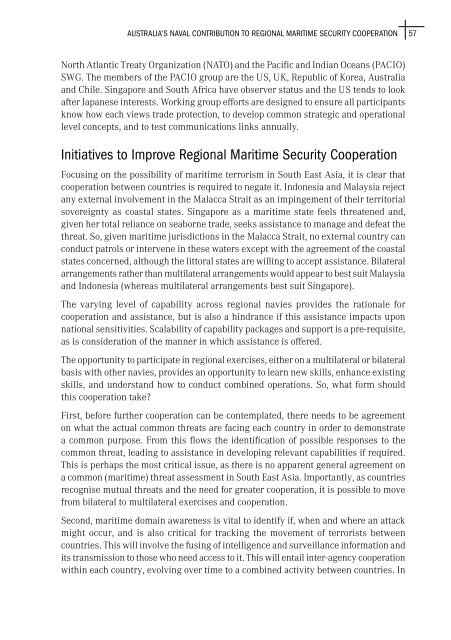Australian Maritime Issues 2007 - Royal Australian Navy
Australian Maritime Issues 2007 - Royal Australian Navy
Australian Maritime Issues 2007 - Royal Australian Navy
You also want an ePaper? Increase the reach of your titles
YUMPU automatically turns print PDFs into web optimized ePapers that Google loves.
Australia’s Naval Contribution to Regional <strong>Maritime</strong> Security Cooperation<br />
57<br />
North Atlantic Treaty Organization (NATO) and the Pacific and Indian Oceans (PACIO)<br />
SWG. The members of the PACIO group are the US, UK, Republic of Korea, Australia<br />
and Chile. Singapore and South Africa have observer status and the US tends to look<br />
after Japanese interests. Working group efforts are designed to ensure all participants<br />
know how each views trade protection, to develop common strategic and operational<br />
level concepts, and to test communications links annually.<br />
Initiatives to Improve Regional <strong>Maritime</strong> Security Cooperation<br />
Focusing on the possibility of maritime terrorism in South East Asia, it is clear that<br />
cooperation between countries is required to negate it. Indonesia and Malaysia reject<br />
any external involvement in the Malacca Strait as an impingement of their territorial<br />
sovereignty as coastal states. Singapore as a maritime state feels threatened and,<br />
given her total reliance on seaborne trade, seeks assistance to manage and defeat the<br />
threat. So, given maritime jurisdictions in the Malacca Strait, no external country can<br />
conduct patrols or intervene in these waters except with the agreement of the coastal<br />
states concerned, although the littoral states are willing to accept assistance. Bilateral<br />
arrangements rather than multilateral arrangements would appear to best suit Malaysia<br />
and Indonesia (whereas multilateral arrangements best suit Singapore).<br />
The varying level of capability across regional navies provides the rationale for<br />
cooperation and assistance, but is also a hindrance if this assistance impacts upon<br />
national sensitivities. Scalability of capability packages and support is a pre-requisite,<br />
as is consideration of the manner in which assistance is offered.<br />
The opportunity to participate in regional exercises, either on a multilateral or bilateral<br />
basis with other navies, provides an opportunity to learn new skills, enhance existing<br />
skills, and understand how to conduct combined operations. So, what form should<br />
this cooperation take?<br />
First, before further cooperation can be contemplated, there needs to be agreement<br />
on what the actual common threats are facing each country in order to demonstrate<br />
a common purpose. From this flows the identification of possible responses to the<br />
common threat, leading to assistance in developing relevant capabilities if required.<br />
This is perhaps the most critical issue, as there is no apparent general agreement on<br />
a common (maritime) threat assessment in South East Asia. Importantly, as countries<br />
recognise mutual threats and the need for greater cooperation, it is possible to move<br />
from bilateral to multilateral exercises and cooperation.<br />
Second, maritime domain awareness is vital to identify if, when and where an attack<br />
might occur, and is also critical for tracking the movement of terrorists between<br />
countries. This will involve the fusing of intelligence and surveillance information and<br />
its transmission to those who need access to it. This will entail inter-agency cooperation<br />
within each country, evolving over time to a combined activity between countries. In
















